Books without readers
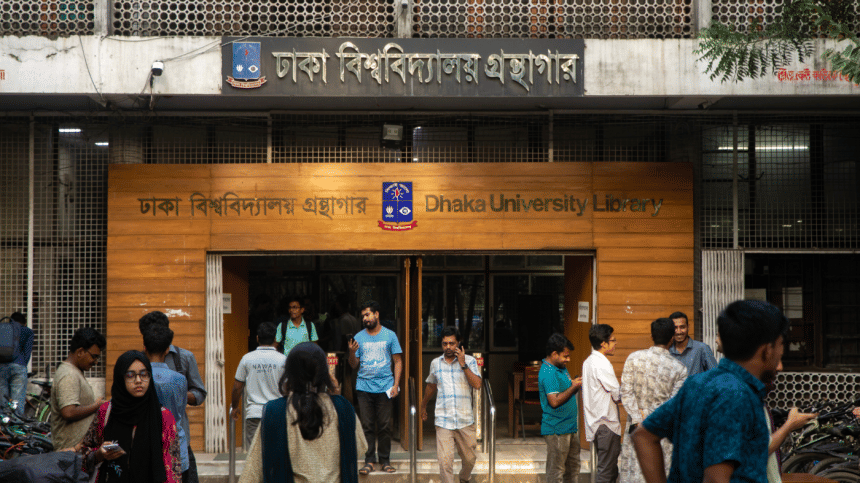
Progga D'Rozario, a master's student in International Business at Dhaka University (DU), was hunting for a copy of Research Methods in Business Studies, published by Cambridge University Press. She scoured the internet in vain. The price tag, USD 63, or roughly BDT 7500, placed it out of reach.
"It is a month of my tuition pay; I cannot squander it all for one book," says Progga D'Rozario when asked about her predicament.
Every year, more than 6000 students enrol at DU, but how many of them know about the orientation programme offered by the DU Central Library, designed to give them access to hundreds of thousands of articles, books and journals from some of the world's leading publishers?
To understand the scale of the issue Campus asked 94 students on the DU campus from different departments and different academic years. The students answered 15 questions, a mix of open and close-ended, aimed at gauging their awareness of the facilities the university provides.

Upon being asked whether they are aware of the orientation programme arranged by the Central Library, 10 percent of students responded positively, 20 percent of students responded that they are unsure and the overwhelming majority, 70 percent of the students, responded negatively.
Aura Shahzad, a postgraduate student at the Department of Clinical Psychology, claims a student who just passed the Higher Secondary Examination (HSC) does not know what a journal is; neither did she. She says, "I did not know that there's an orientation programme to teach students about the repository. I would've attended it had I known about it. For Psychology students, journals are our bread and butter because we write everything based on the works of other scholars in the field. It would've helped me to get study materials as well as the fourth-year monograph."
According to our survey, 62.5 percent never tried to access the library's resources, 35 percent tried but failed, and the rest (2.5 percent) responded that they tried and were successful. Those who were successful attended the orientation programmes hosted by the library.
According to several students from the 2024–25 session, none of them had heard of the orientation programme. When asked if their departments had sent any notices about it, they said no. Furthermore, the majority (92.5 percent) believes the authority did not take proper measures to ensure that the students know about the university's access to major publications.
Ansuwa Karmokar, a student of Statistics, Biostatistics & Informatics, says, "We attended the orientation programme, but at the time we did not know what these meant or what their implications were. As a result, I have forgotten about it and use Sci-Hub to download the papers I want to read."
Rahee Nayab, a fourth-year Journalism student, shared the same thoughts as Ansuwa. He said that despite learning about the orientation programme, he did not retain much from it. He says, "If the library authorities focused more on how to get the library cards or showed us around the library instead of putting us in a room and giving us a lecture on things we do not know anything about as first-year students. Students usually put off creating the library card because the process is lengthy and daunting."
| Sesscion |
Attendee Students |
Total Departments (of 83) |
|---|---|---|
|
2016-17 |
1310 (of 6800) |
13 |
|
2021-22 |
3101 (of 7133) |
66 |
| 2022-23 |
2889 (of 6035) |
64 |
According to official data provided by DU Library officials, in 2016-17 only 19.27 percent of students, in 2021-2022 only 43.47 percent, and in 2022-23 only 47.87 percent of students attended the orientation programmes. Meaning that over half of the students continually fail to attend the library orientation programme.
"I did not attend the orientation programme because I didn't think it was necessary. As a first-year student, I didn't feel I needed to understand something that seemed so complex," says Ragib Shahriar, a graduate student of Economics. He believes both the library and the department should place more emphasis on the importance of attending the orientation.
One perspective gleaned from the interviews is that students found the process to be not student-friendly.
The process of getting remote access is shaped by a number of factors, including a student's department and hall. This ordeal includes creating a hall ID card, filling out the library card form, getting the form signed by the hall provost. After getting the signature the student has to pay a fee at the Janata Bank TSC branch and keep the receipt. The student then takes the documents to the first floor of the library. Now you can get the remote access.
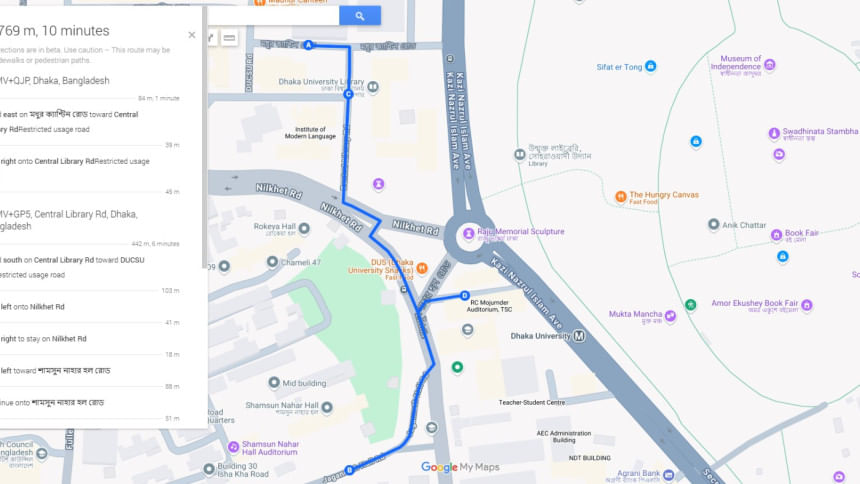
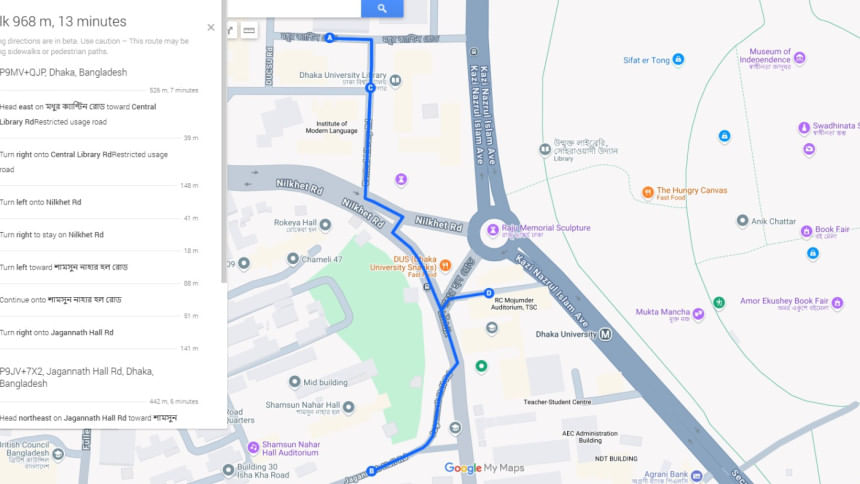
The annotated diagrams were created using the My Map feature of Google Maps to give an estimation of the distance and to illustrate the mandatory footsteps a student of Journalism attached with Shamsunnahar Hall needs to walk to get remote access. It will take the student approximately 2266 footsteps and a week to obtain remote access.
To compare this process of obtaining remote access with a private university, students of various private universities were reached.
Raian Abedin, a fourth-year student in the Department of Biochemistry and Biotechnology at North South University (NSU), says, "We have to email our librarian for an OpenAthens account, which is how we get a personal username and password. Logging in enables us to access most papers that we need. It gives me access to everything I personally need."
At NSU, students do not need a library card to get remote access. This stands in sharp contrast to the process at DU. Thus, to put things into perspective, a student from NSU takes zero footsteps, and a journalism student attached to Shamsunnahar Hall has to take almost 2266 steps.
In conversation with Senior Technical Officer Md Symon Islam, one thing became clear: crores of taka are being spent to provide access to high-cost journals from publishers. "Students usually go for pirated copies and do not realise we offer a better collection. Last year, almost two crore taka was spent to ensure access," he says.
| Year |
Budget for Journals (in BDT) |
|---|---|
|
2011-2012 |
124.00 Lacs |
|
2016-2017 |
155.00 Lacs |
|
2023-2024 |
257.10 Lacs |
|
2024-2025 |
226.70 Lacs |
In the 2011-12 academic year, the journal budget was just over one crore taka. By 2023, it had climbed to more than two and a half crores. But while the funding has grown, its impact appears to have stalled.
After 2020, budget details vanished from official reports, and university officials seem unable to explain why. Students, meanwhile, continue to rely on pirated materials simply because they do not know better options exist. Without awareness and access, even the most generous academic investment fails to become a worthwhile expenditure, seen by no one and benefiting few.
When presented with the interview findings showing that 70 percent of students are unaware of the orientation programme and the university's access to international journals, and asked about the library's lack of initiative in ensuring student participation, Mohammad Azharul Haque, Deputy Librarian at DU Central Library responded, "We always send notice to each department. What are we going to do when they are not relaying the information?"
Dr Kazi Mostak Gausul Hoq, Librarian of DU Central Library, was confused when confronted with the data we collected of the students. He was distressed to accept the fact that 70 percent of students did not know that DU Central Library has access to international journals and 92.5 percent of students believe that the university did not take proper measures to ensure that the students know about the university's access to major publications.
This should not come as a surprise when the official data offered by the library illustrates that more than 50 percent of students fail to attend the library orientation programme. When asked about the data provided by his office, he says, "We keep an attendance sheet but at the end do nothing about the low participation, which is true." He also added that recommendations are not made because of the lack of demands from the students' end.
However, when presented with the information that students want to know about these facilities, Dr Kazi Mostak could not give a clear answer and spoke about the recommendations that are going to be made to the Pro-Vice Chancellor at the upcoming meetings.
Testimonies from students of the 2024–25 session were presented to the authorities, questioning why an entire batch of over 6000 students had not received the orientation programme. Mohammad Azharul Haque explained that there were administrative hurdles after August 5, 2024 which prevented them from holding the sessions. Later, he spoke about a plan to combine first-year and second-year students from each department to make up for the library's shortcomings.
Students like Progga D'Rozario, Rahee Nayab, and Aura Shahzad are victims of empty promises of digitisation. What they were told and what they have experienced tell two entirely different stories. While the authorities claim the system is being improved and digital access is expanding, the data tells a harsher truth. 70 percent of students do not even know that Dhaka University provides access to international journals.
More than half never attended the orientation programme that is supposed to guide them through these facilities. Among those who did, many left confused, unsupported, unaware of what was available and why it was necessary. The gap between the administration's words and the students' reality reveals inefficiency and neglect. In the end, students are left to fend for themselves in a system that claims to support them but rarely shows up when it matters most.
Azra Humayra is majoring in Mass Communication and Journalism at the University of Dhaka. Find her at: [email protected]

 For all latest news, follow The Daily Star's Google News channel.
For all latest news, follow The Daily Star's Google News channel. 




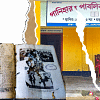

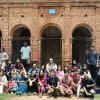



Comments